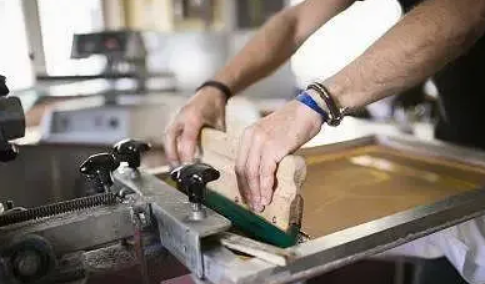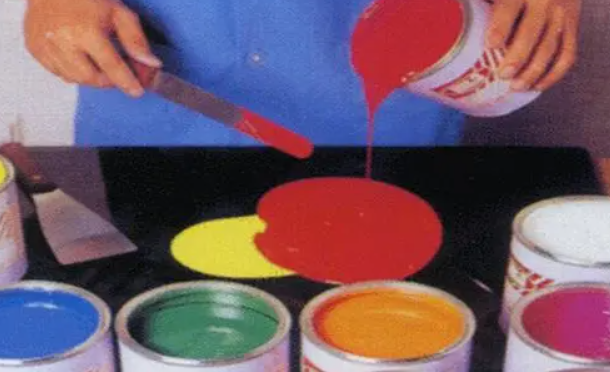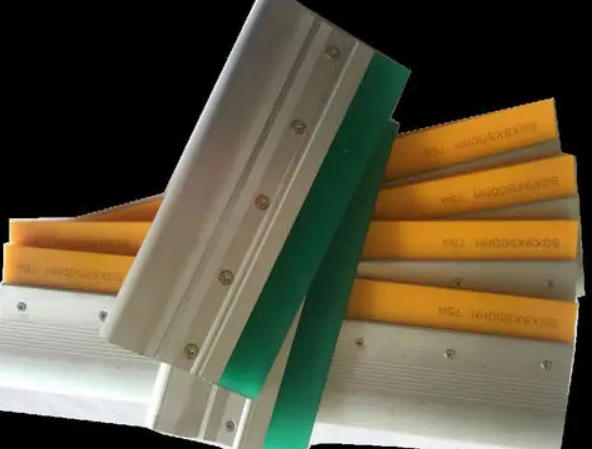Guide: Silk printing is a very common graphic printing process in the manufacture of cosmetic packaging materials. Through the combination of ink, screen printing screen, and screen printing equipment, the ink is transferred to the substrate through the mesh of the graphic part. During the process, the screen printing The color will be affected by some factors and change. This article is packaged by shanghai rainbow package, and I will share with you several factors that affect the color change of silk screen.
screen printing
The screen printing process is that the ink passes through part of the mesh of the screen and then leaks onto the substrate. The remaining part of the screen is blocked and the ink cannot penetrate. When printing, the ink is poured on the screen. Without external force, the ink will not leak through the mesh to the substrate. When the squeegee scrapes the ink with a certain pressure and tilt angle, it will transfer through the screen. To the following substrate to realize the copy of the image.

01 Ink blending
Assuming that the pigments in the ink are properly formulated, the usual cause of color changes is the added solvent. In a well-controlled workshop, the ink should be supplied to the printing press at any time after it is ready, that is to say, the printer should not mix the ink. In many companies, the ink is not adjusted and supplied to the printing press, but is left to the printers to adjust, and they add and mix the ink according to their own feelings. As a result, the pigment balance in the ink is broken. For water-based common ink or UV ink, the water in the ink acts in the same way as the solvent in the solvent ink. Adding water will thin the dried ink film and affect the color of the ink, thereby reducing the density of the color. . The reasons for such problems can be traced further.

In the ink warehouse, the ink mixing workers do not use the weighing device, and only rely on their own judgment to add the right amount of solvent, or the initial mixing is inappropriate, or the ink mixing amount changed during printing, so that the mixed ink will be Produce different colors. When this job is printed again in the future, this situation will get worse. Unless there is enough ink to record, it is almost impossible to reproduce a color.
02 Screen selection
The wire diameter of the screen and the way of weaving, that is, plain or twill, have a great influence on the thickness of the printed ink film. The screen supplier will provide detailed technical information of the screen, the most important theoretical ink volume, which represents the amount of ink passing through the screen mesh under certain printing conditions, generally expressed in cm3/m2. For example, a 150 mesh/cm screen with a mesh diameter of 31μm will be able to pass 11cm3/m2 of ink. A mesh with a diameter of 34μm and a 150-mesh screen will pass 6cm3 of ink per square meter, which is equivalent to 11 and 6μm thick wet ink layers. It can be seen from this that the simple representation of 150 mesh will make you get significantly different ink layer thicknesses, and the result will cause a big difference in color.
With the improvement of wire mesh weaving technology, it is necessary to obtain a certain number of twill wire mesh instead of plain wire mesh. Although this is sometimes possible, the possibility is very small. Sometimes screen suppliers store some old twill screens. Generally speaking, the theoretical ink volume of these screens varies by 10%. If you use a twill weave screen to print fine-grained images, the phenomenon of fine line breakage is more than that of a plain weave screen.
03 Screen tension
The low tension of the screen will cause the screen to separate slowly from the printed surface, which will affect the ink staying on the screen and cause effects such as color unevenness. In this way, the color appears to have changed. To solve this problem, the screen distance must be increased, that is, the distance between the horizontally placed screen plate and the printing material must be increased. Increasing the screen distance means increasing the pressure of the squeegee, which will affect the amount of ink passing through the screen and cause further changes in color.
04 Setting of squeegee
The softer the squeegee used, the more ink will pass through the screen. The greater the pressure acting on the squeegee, the faster the blade edge of the squeegee wears during printing. This will change the contact point between the squeegee and the printed matter, which will also change the amount of ink passing through the screen, and thus Causes color changes. Changing the angle of squeegee will also affect the amount of ink adhesion. If the squeegee runs too fast, this will reduce the thickness of the attached ink layer.

05 Setting of ink-return knife
The function of the ink-returning knife is to fill the screen holes with a stable amount of ink. Adjusting the pressure, angle and sharpness of the ink-returning knife will cause the mesh to be overfilled or underfilled. Excessive pressure of the ink-return knife will force the ink to pass through the mesh, causing excessive ink adhesion. Insufficient pressure of the ink-returning knife will cause only part of the mesh to be filled with ink, resulting in insufficient ink adhesion. The running speed of the ink return knife is also very important. If it runs too slowly, the ink will overflow; if it runs too fast, it will cause serious ink shortage, which is similar to the effect of changing the running speed of the squeegee.
06 Machine setting
Careful process control is the biggest key factor. The stable and consistent adjustment of the machine means that the color is stable and consistent. If the adjustment of the machine changes, then the color will lose control. This problem usually occurs when printing workers change shifts, or later printing workers change the settings on the printing press at will in order to adapt to their own habits, which will cause color changes. The latest multi-color screen printing machine uses computer automatic control to eliminate this possibility. Make these stable and consistent settings for the printing press and keep these settings unchanged throughout the printing job.
07 Printing materials
In the screen printing industry, an aspect that is often overlooked is the consistency of the substrate to be printed. The paper, cardboard and plastic used in printing are generally produced in batches. A high-quality supplier can guarantee that the entire batch of materials it provides has good surface smoothness, but things are not always the case. During the processing of these materials, any slight change in the process will change the color and color of the material. Surface finish. Once this happens, the printed color looks to change, although nothing has changed during the actual printing process.
When we want to print the same pattern on a variety of materials, from corrugated plastic board to fine art cardboard, as a publicity advertisement, printers will encounter these practical difficulties. Another problem that we often encounter is that our screen printing has to catch up with the offset image. If we do not pay attention to the process control, we have no chance. Careful process control includes accurate color measurement, the use of a spectrophotometer to determine the line color, and a densitometer to determine the three primary colors, so that we can print stable and consistent images on a variety of materials.
08 light source
Under different light sources, colors look different, and human eyes are very sensitive to these changes. This effect can be reduced by ensuring that the colors of the pigments used in the entire printing operation are accurate and consistent. If you change suppliers, this could be a disaster. Color measurement and perception is a very complex field. To achieve the best control, there must be a closed loop composed of ink manufacturers, ink blending, proofing and accurate measurement in the printing process.
09 dry
Sometimes the color changes due to improper adjustment of the dryer. When printing paper or cardboard, if the drying temperature is adjusted too high, the general situation is that the white color turns yellow. The glass and ceramic industries are most troubled by color changes during drying or baking. The pigment used here has to be completely changed from the printed color to the sintered color. These sintered colors are not only affected by the baking temperature, but also by oxidation or reduced air quality in the baking area.
Shanghai Rainbow Industrial Co., Ltd is the manufacturer, Shanghai rainbow package Provide one-stop cosmetic packaging.If you like our products, you can contact us,
Website: www.rainbow-pkg.com
Email: Bobby@rainbow-pkg.com
WhatsApp: +008613818823743
Post time: Nov-04-2021




